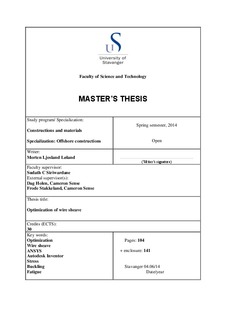| dc.description.abstract | The objective of this thesis is to optimize a 72” (1828,8 mm) wire sheave with respect to weight and rotational inertia. The sheaves are used as pulleys on derrick structures. Seven different design concepts were designed and analyzed. Table 1 shows the different concepts with their capacities.
Tabell 1: Results
Concept Stress capacity Buckling capacity Fatigue capacity Weight [kg] Moment of inertia [kg*mm2]
1. Double web 52 % 35 % 102 % 647 2,46*108
2. Straight web 72 % 63 % 70 % 622 2,38*108
3. Straight web w/holes 82 % 66 % 67 % 531 2,02*108
4. Double web w/holes 44 % 26 % 84 % 620 2,32*108
5. Thin web w/ stiffeners 70 % 73 % 72 % 531 1,97*108
6. Thin web w/ stiffeners and holes 96 % 71 % 72 % 516 1,92*108
7. Web with decreasing thickness 82 % 84 % 73 % 520 1,90*108
The design concepts may be described as follows:
1. The first design concept, double web, was given by Cameron Sense as an educational purpose to learn the different programs being used. The result of the analysis shows good capacity against side loads and buckling, but the weight is relatively high.
2. The next concept, a straight web, had to be thick enough to withstand the stress at the inner edge. Therefore the weight was not reduced much.
3. In the third concept holes were made in the straight web. Since the stresses increase towards the center of the sheave, the holes had to be put as close as possible to the outer edge of the sheave. The weight was reduced by 90kg when adding eight holes around the sheave.
4. The fourth concept consisted of the double web sheave from Cameron, but with holes in it. Since this concept consisted of two thin webs, cylinders (sleeves) had to be placed in the holes to avoid local buckling. The weight was not reduced much due to the weight of the cylinders that were added.
5. The next two concepts were a thin web with six stiffeners around the sheave and one with holes between the stiffeners. These concepts had low weight, but the results are questionable. The side load was applied right above one of the stiffener. When the sheave rotates, this load will act on different places, also in between the stiffeners. This will give bending stresses at the web as well. Therefore more investigations will be required to conclude these concepts.
6. The last concept was having a web with a decreasing thickness. With a weight of 520,1kg this was, beside from the concept with thin web and stiffeners and holes, the sheave the lowest mass.
The sheave with decreasing thickness of the web had low weight and good utilization on all the disciplines that were checked. The fatigue capacity was pretty high on all the concepts when checking with the D-curve from DNV. The spectrum supplied by Cameron Sense is intended to drill 100 deep wells over a period of 20 year, which results in 200 million fatigue cycles. When the traveling block is moving up, from the work that it has done, the sheave is not fully loaded. This results in a reduction of fatigue cycles. The fatigue cycles are reduced to 100 million cycles. This gives a higher allowable stress for fatigue. Making design concept 2,3,5,6 and 7 casted will result in a component with no welds. This gives a C-curve and a reduction factor for the stress range. With the new stress range, and the new S-N curve, the fatigue capacities on most of the sheaves are considered acceptable.
Optimizing sheaves and other equipment is essential, since the world is facing difficulty with cost of new constructions. The light sheave that Cameron Sense is using weighs 646,5 kg, but most of the sheaves being used weighs about 800 kg. Using the sheave with a decreasing thickness on the web, the weight is reduced with 126,4 kg from the light sheave Cameron uses, and approximately 280 kg from the regular sheaves being used. In a 14 parts system this will reduce the total weight of sheaves by 3,92 tons and 4,48 tons in a 16 parts system. | nb_NO |
